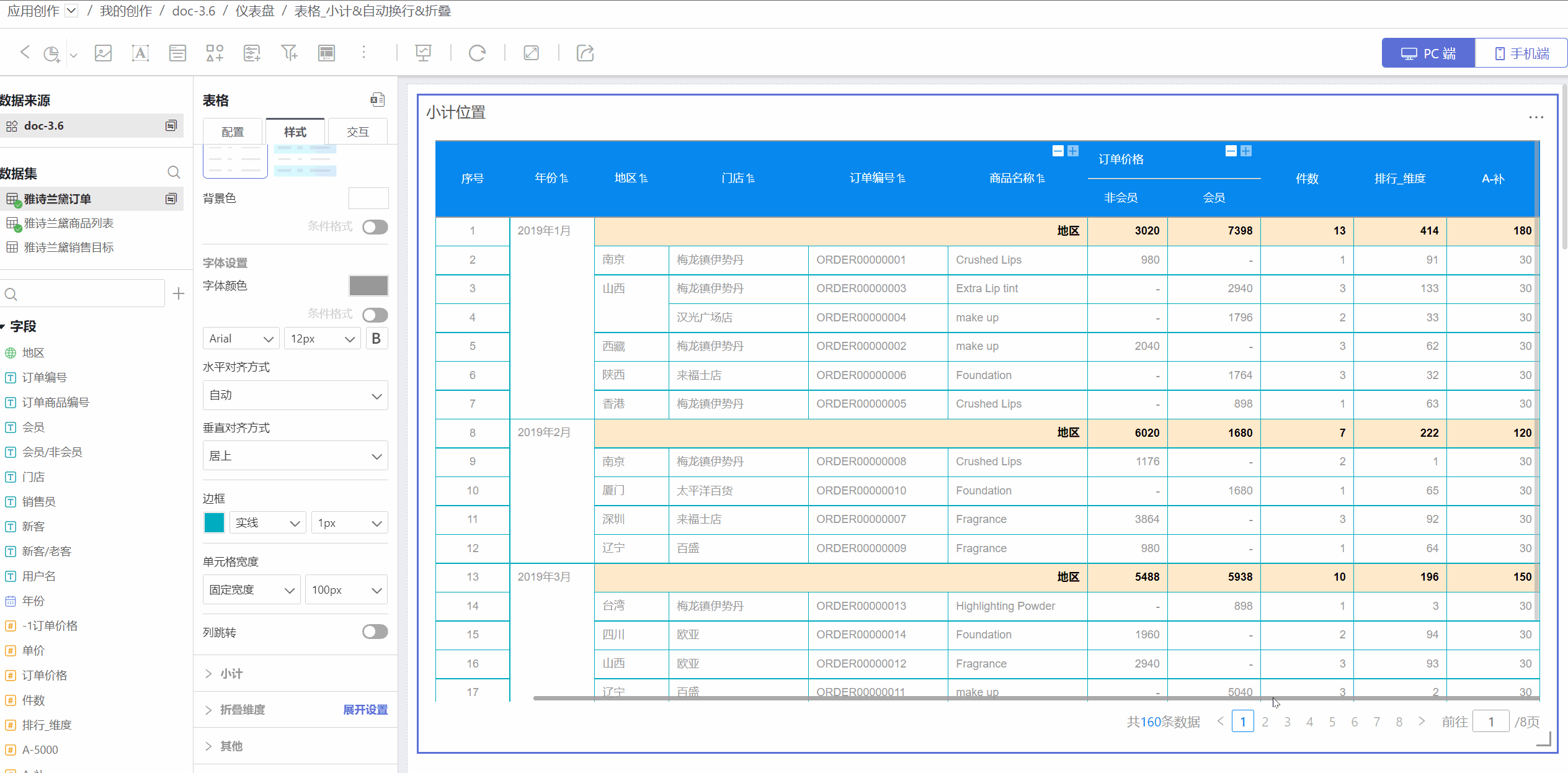Table Style Settings
In table-type controls, you can set the table header, cell, field styles, etc., to make the table display more aesthetically pleasing and allow users to access data more intuitively and conveniently.
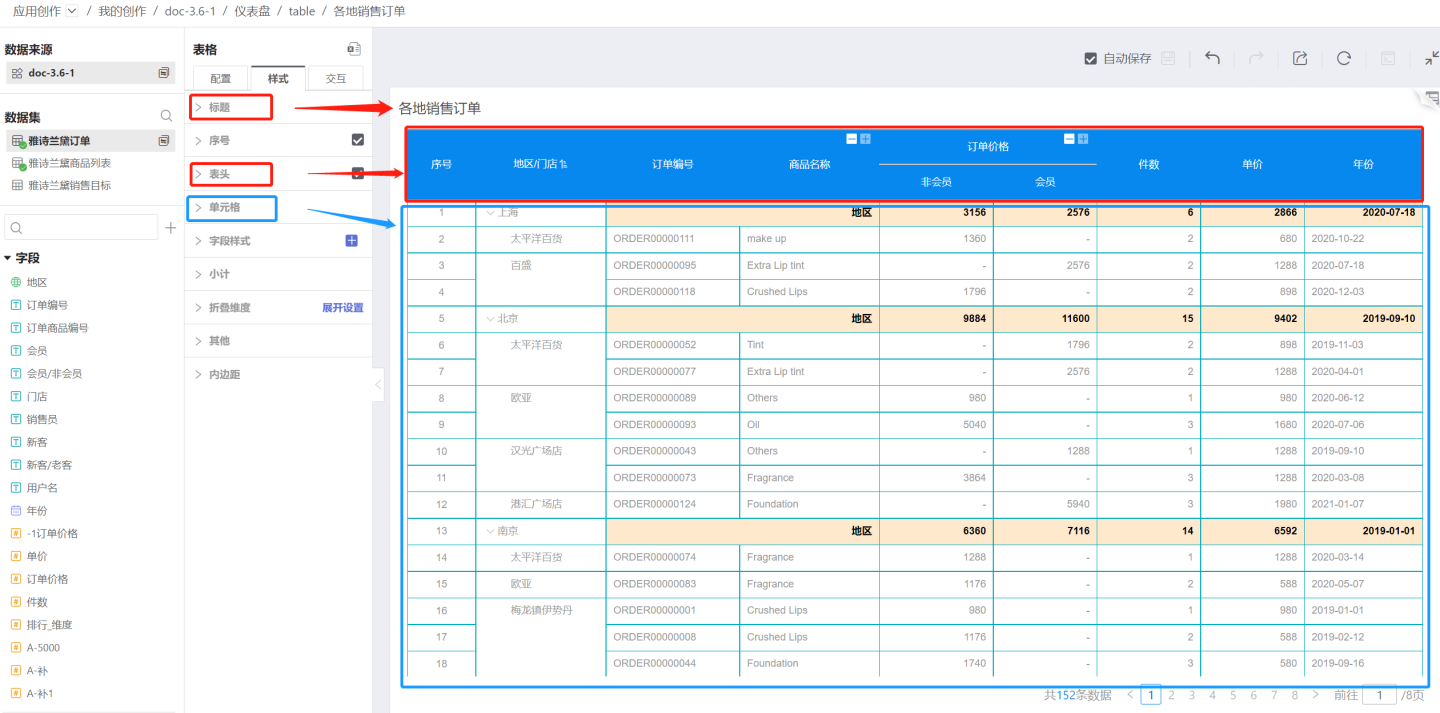
The table supports settings for titles, serial numbers, headers, cells, field styles, subtotals, collapsed dimensions, and other auxiliary functions. Below is a detailed introduction to the functions and display effects of each style.
Title
Tables support setting display titles, custom titles, title colors, and title positions.
Table Numbering
Tables support adding numbers to facilitate users in finding data.
Data analysts use tables to create data charts and want to achieve a leaderboard display effect. They can set the numbering style for the top 3 data items. Configuration path: Style > Content > Numbering > Top 3 Numbering Style. 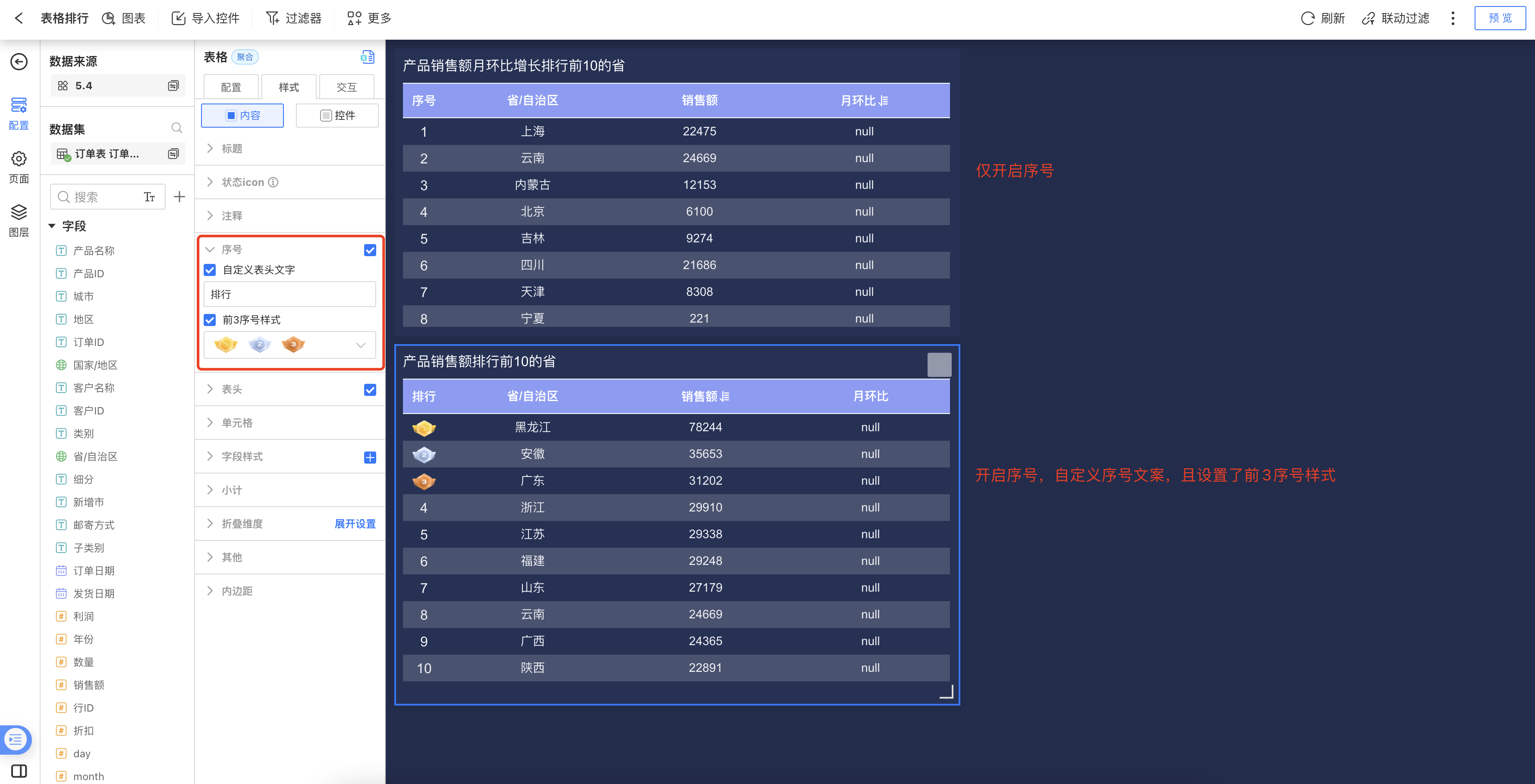
Table Header
Tables support settings for the display, font, color, borders, etc., of the table header.
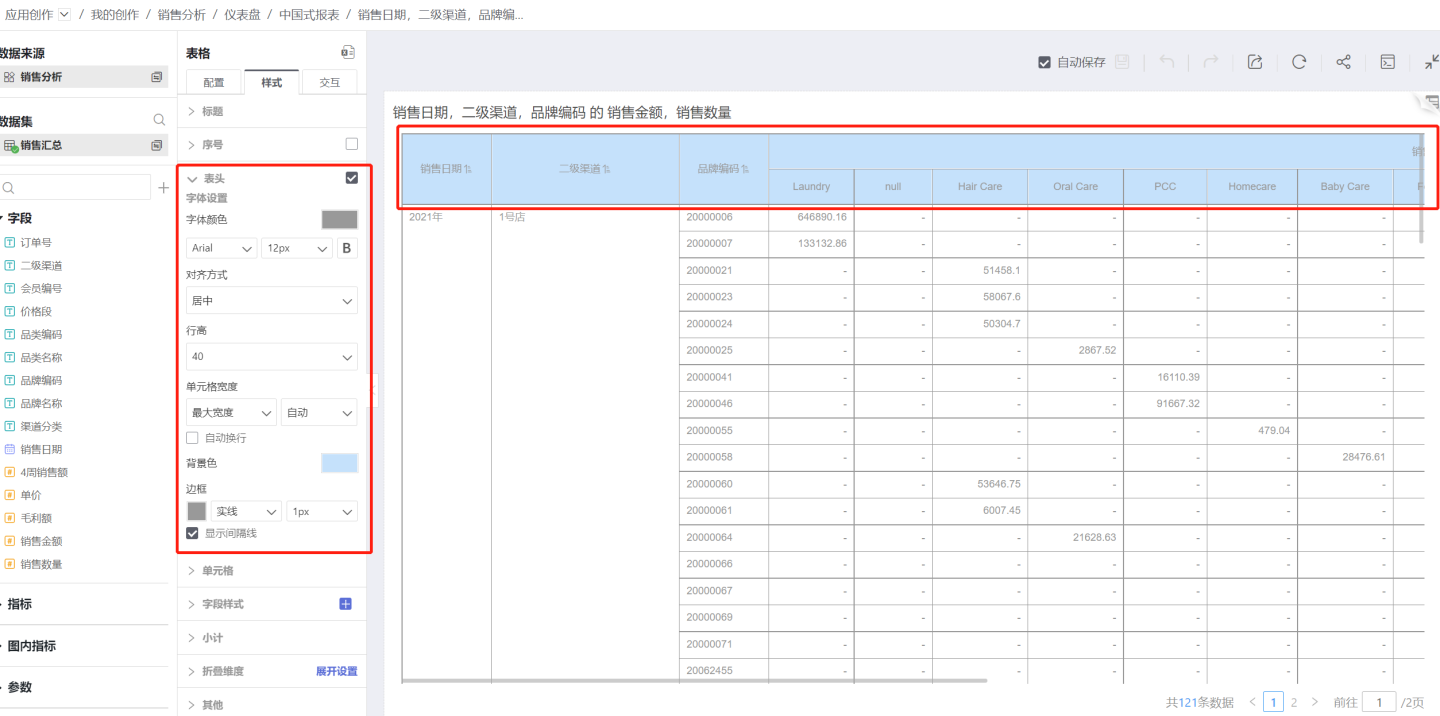
Display Header Tables can be set to display or hide the header. By default, the header is displayed. If it is not needed, uncheck the option.
Text Settings Supports settings for font color, font type, font size, bold, etc.
Alignment Refers to the horizontal alignment of text within the header cell. Header text is centered by default.
Row Height The height of a single header row can be set, with a range of 30-120px.
Cell Width To uniformly set the width of table cells, the cell width must be set in the header.
Auto Mode: When set to auto, the cell width changes according to the length of the content.
Maximum Width: If the cell content exceeds the set range, it maintains the maximum width. If it is less than the maximum width setting, it adapts to the width. The maximum width needs to be set to a specific value.
Fixed Width: Displays the cell according to the set fixed width. The fixed width needs to be set to a specific value.
Auto Wrap: When the content is too long to display entirely, the auto wrap function can be set. This function only works under maximum width and fixed width settings and does not work in auto mode.
Background Color The header background color only supports a single solid color without transparency.
Display Separator Line By default, it is checked. Unchecking it means hiding the separator line.
Measure Grouping Display
The table header can use the measure grouping feature to display the relationships and groupings between measure fields.
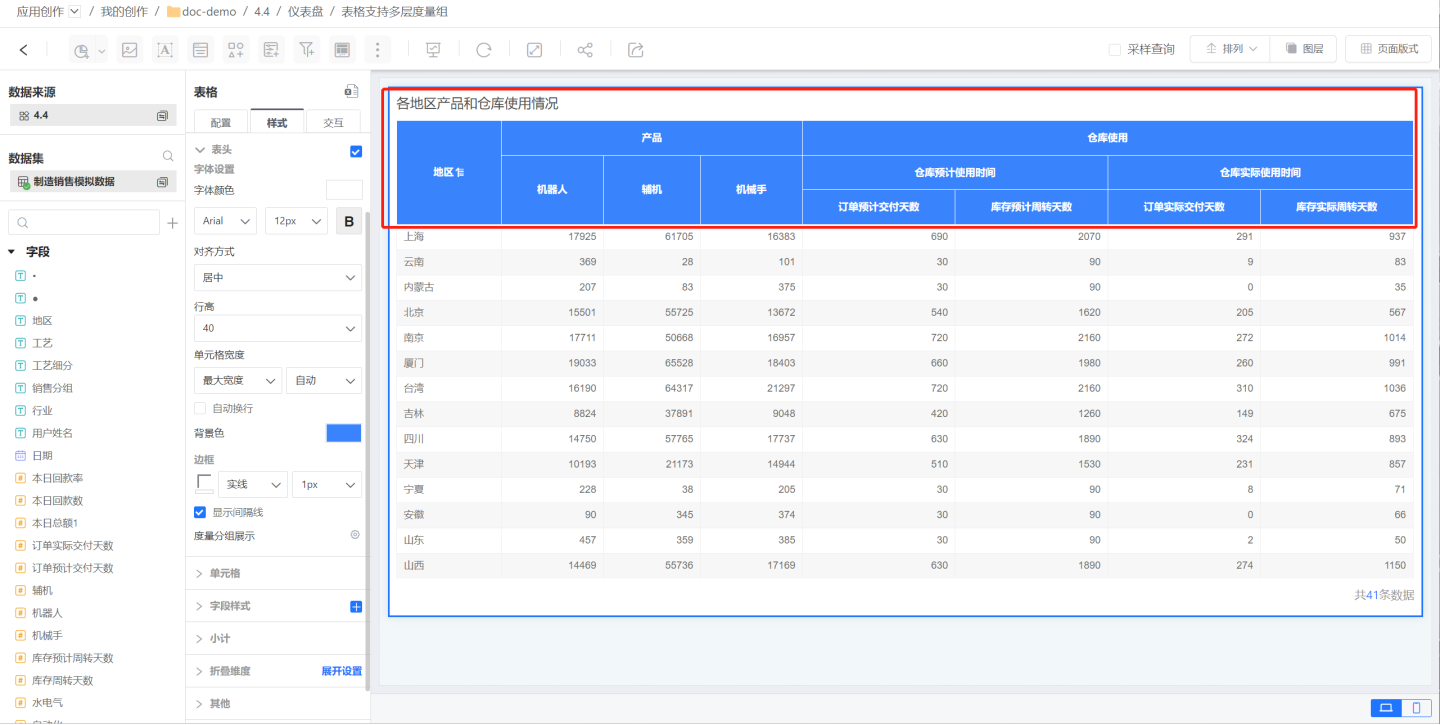
Click on the measure grouping display to pop up the measure grouping edit box. Click on "Add Group" to display the newly created measure group at the bottom.
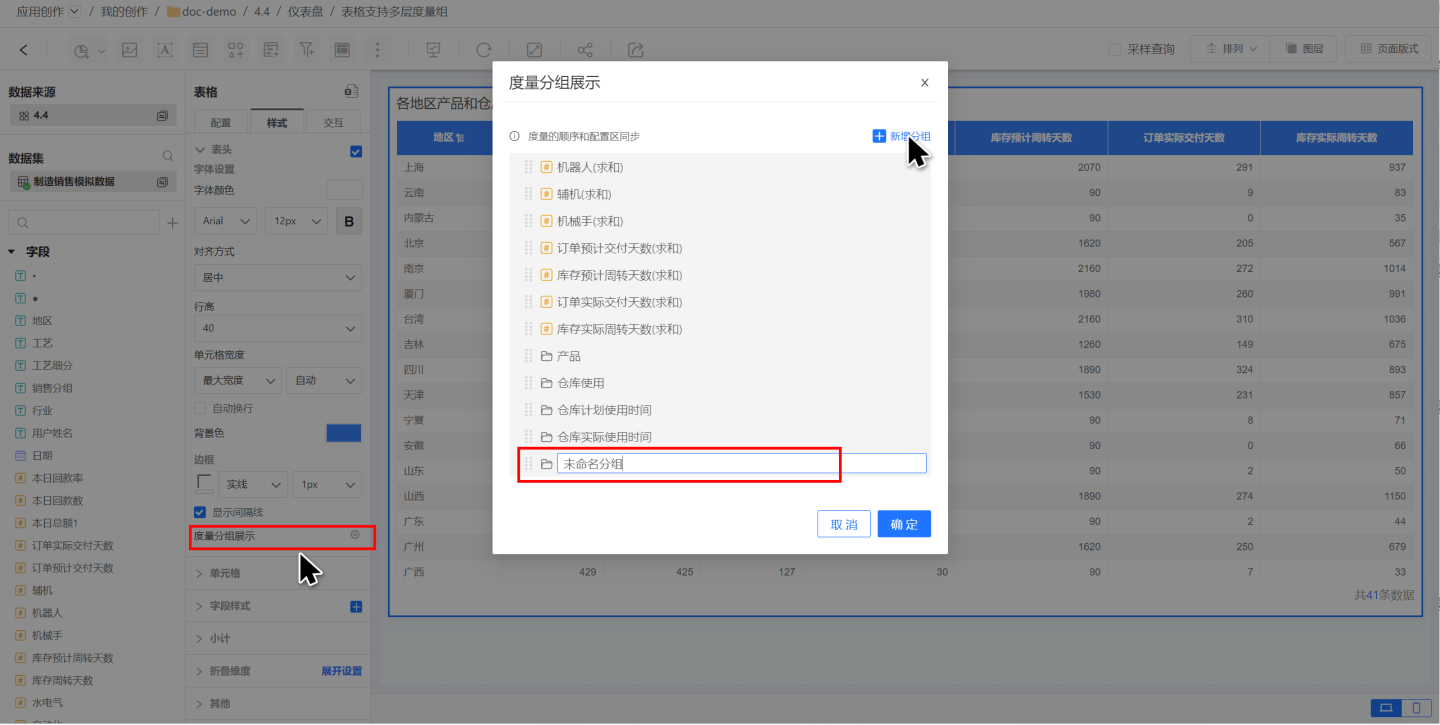
In the edit box, drag and drop measure information to adjust the display hierarchy of measure groups, showing the multi-level relationships between fields.
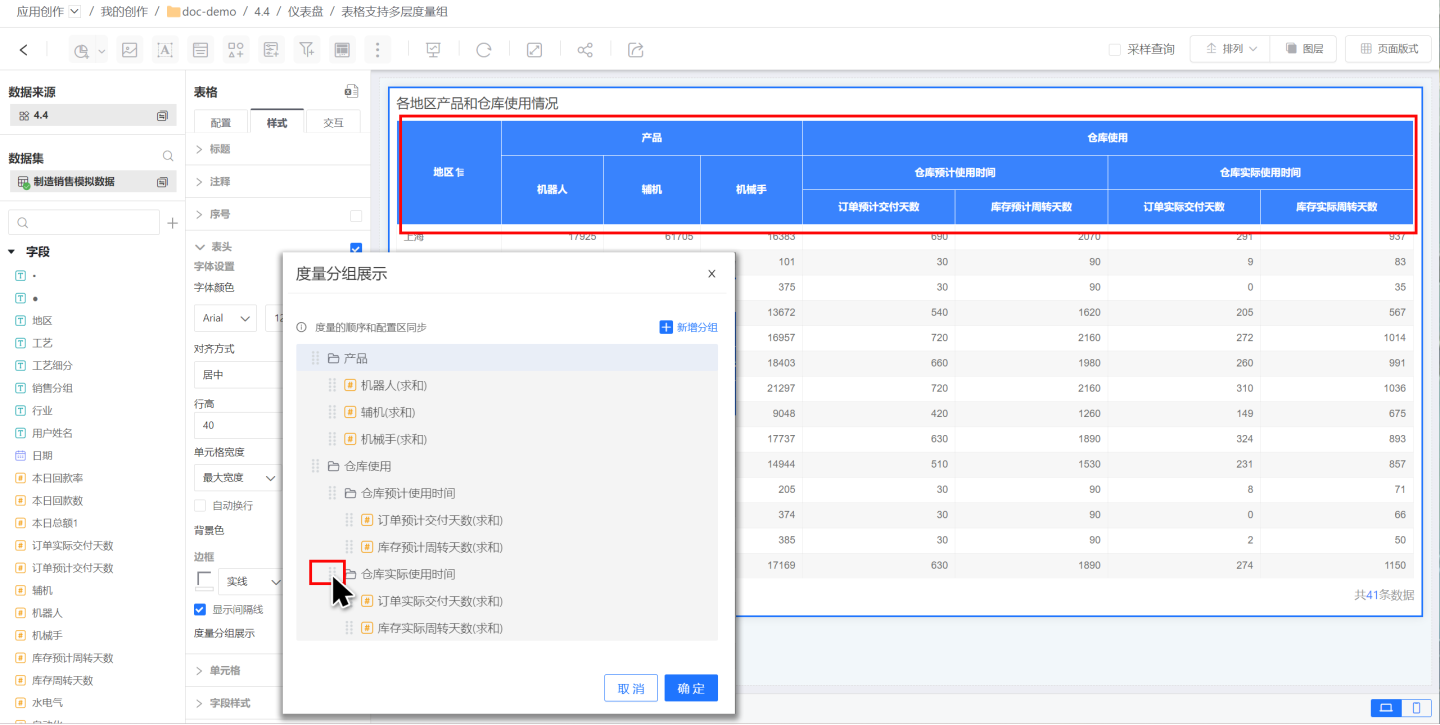
After setting up the measure grouping, if the order of measure fields is adjusted, the measure grouping information is automatically adjusted, and the display in the table header changes accordingly. 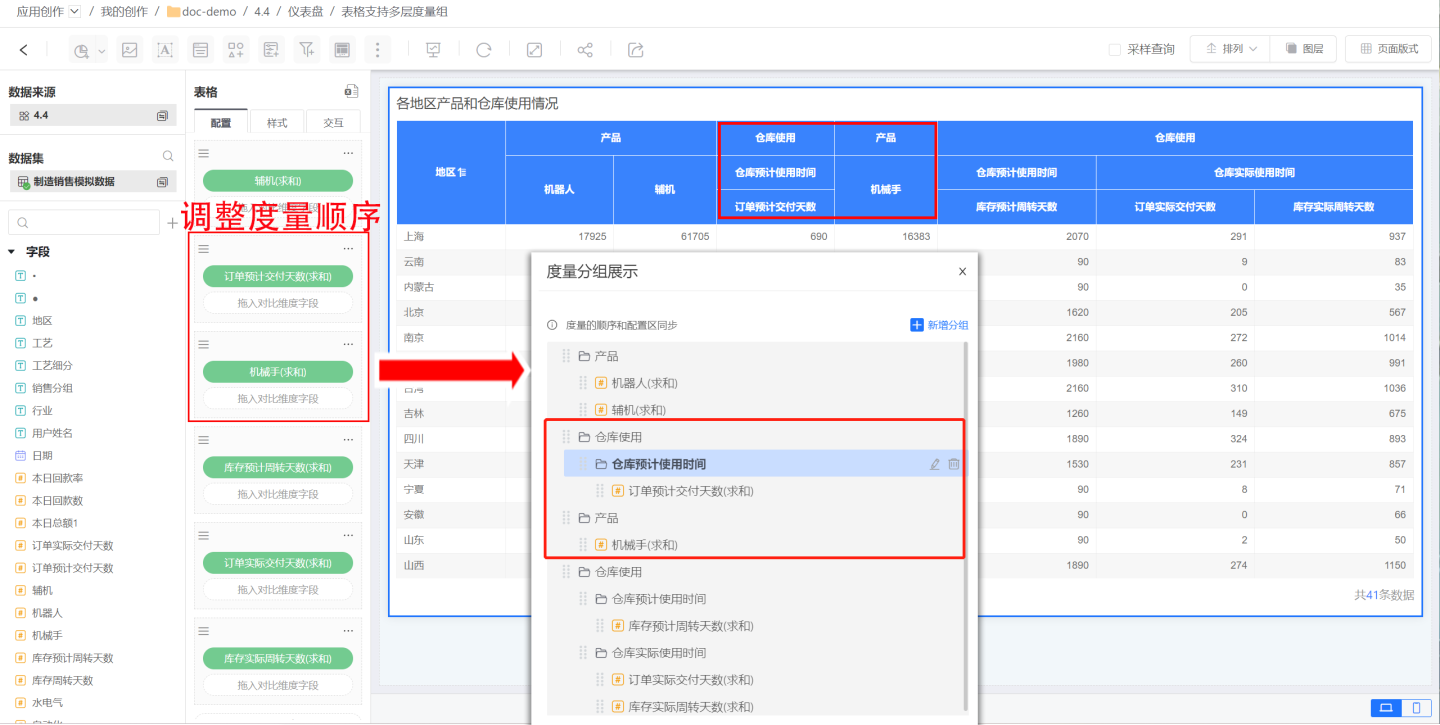
Tip
- Measure grouping is different from measure groups. Measure grouping only has a display function, while measure groups, in addition to the display function, also support merging operations on the comparison dimensions of measures within the group.
- Measure grouping can display multi-level relationships between measures, while measure groups only support displaying a single level.
Cells
You can set the background color, text color, row height, borders, etc. for cells.
Background Color You can set the background of cells, supporting same color for alternate rows (left card) and different colors for alternate rows (right card). The default setting is same color for alternate rows.
- Same Color for Alternate Rows: This means that the table rows are uniformly set without distinction. Color settings support single color and transparency settings.
- Different Colors for Alternate Rows: Two background color values need to be set, and they will be displayed alternately by row. Color settings support single color and transparency settings.
Text Settings Supports settings for font color, font type, font size, bold, etc.
Alignment Refers to the horizontal alignment of text within the cell. Includes automatic, left, center, and right. The default alignment is automatic. Automatic alignment means aligning according to the field type, such as text automatically aligning to the left and numbers automatically aligning to the right.
Row Height Set the height of the cell, ranging from 30-120px.
Merge Cells Merge cells with the same data within the same column.
Display Grid Lines By default, it is checked. Unchecking it means hiding the grid lines.
Field Styles
Cell settings apply to all cells in the entire table. If you need to apply special settings to a specific column or several columns, you can do so in the field styles.
In addition to basic cell settings, field styles also support setting up jumps.
Adding Field Styles:
Click the "+" sign on the right side of Field Styles to enter the field selection popup. Select the fields that need column style settings, and you can choose multiple fields.

After clicking save, a field style will be generated under Field Styles.
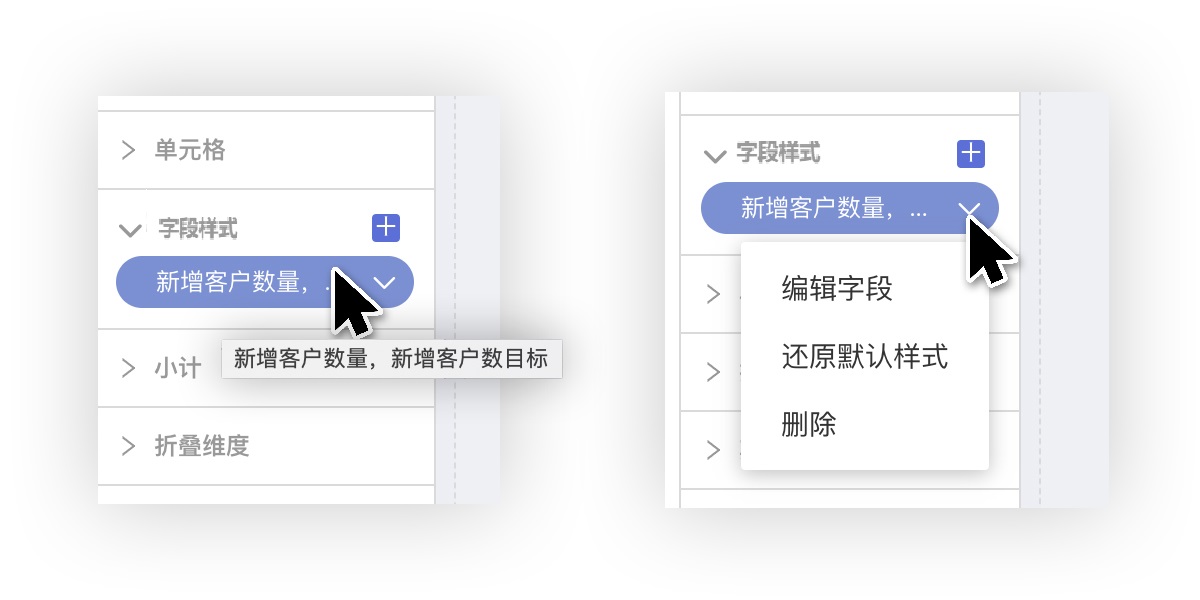
Setting Field Styles
After adding field styles, click to perform the following style settings.
Background Color In addition to supporting same-color and alternating-color settings for rows, background color also supports conditional formatting.
Text Settings Supports setting font, font color, font size, and bold. Font color supports conditional formatting.
Horizontal Alignment Refers to the horizontal alignment of text within a cell. Options include automatic, left, center, and right. The default alignment is automatic. Automatic alignment means aligning according to the field type, such as text automatically aligning to the left and numbers automatically aligning to the right.
Vertical Alignment Refers to the vertical alignment of text within a cell, including top, center, and bottom.
Cell Width To uniformly set the width of table cells, you need to set the cell width in the header.
- Auto Mode: When set to auto, the cell width changes according to the length of the content.
- Maximum Width: If the cell content exceeds the set range, it maintains the maximum width. If it is less than the maximum width setting, it adapts to the width. The maximum width needs to be set to a specific value.
- Fixed Width: Displays the cell according to the set fixed width. The fixed width needs to be set to a specific value.
- Auto Wrap: When the content is too long to display entirely, you can set the auto wrap function. This function only works under maximum width and fixed width settings and does not work in auto mode.
Column Jump Set the jump operation for field styles. The specific operation is the same as the jump setting in Table->Control Settings->Jump.
Tip
- After setting the jump in the table, clicking a cell executes the jump operation, but clicking the header does not trigger the jump.
- The jump setting in Table->Control Settings applies to the entire table. When a field style jump is set, clicking the field style only triggers the jump setting of the field style.
Conditional Formatting Settings
Conditional formatting refers to rendering the color of cells by setting conditions. Both the background and font of cells support conditional formatting, making cells more prominent, allowing users to identify data that meets certain conditions through color. For example, in a student report card, green indicates scores above 90, and blue indicates scores above 80. Conditional formatting can control the display of a specific field or an entire row of data. Below are the related configurations for conditional formatting. 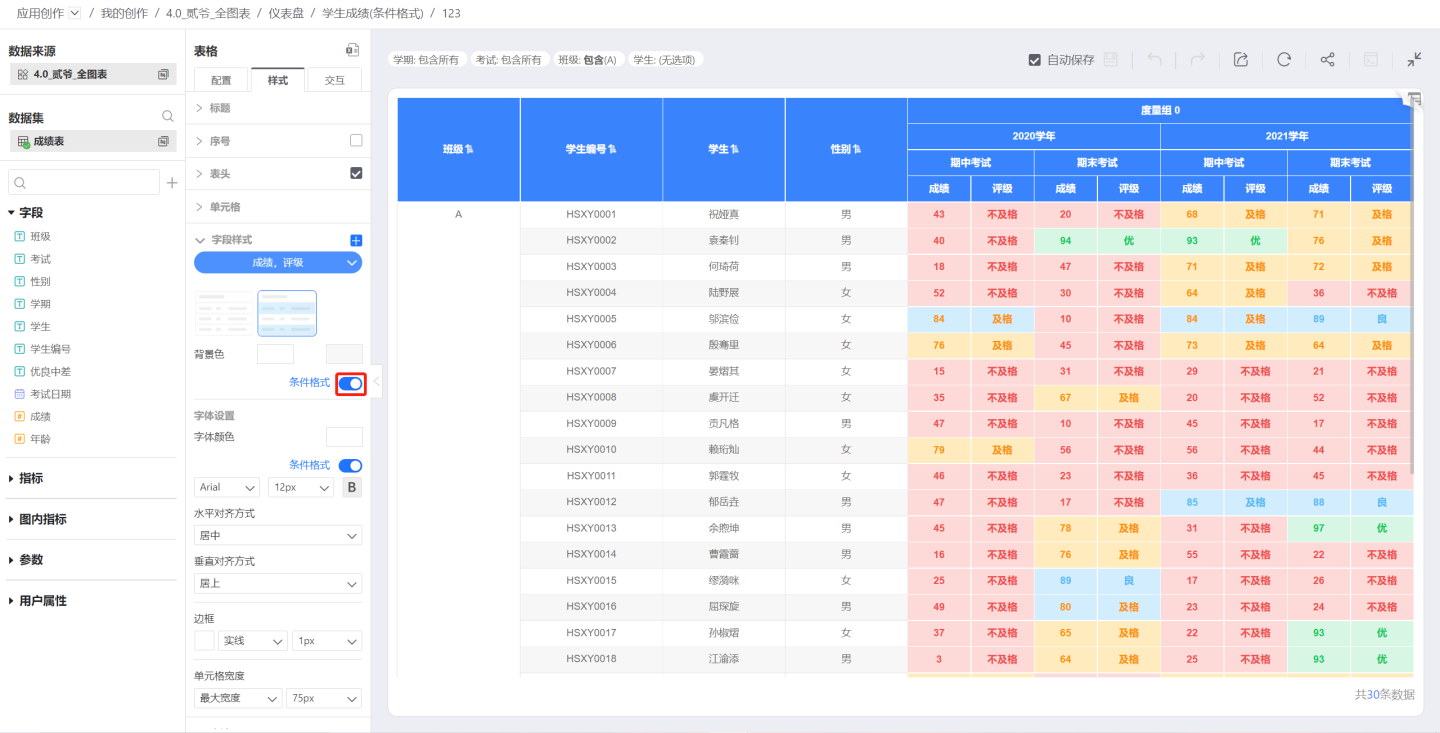
Color Scale
Set conditional formatting using color scales, including by palette, custom, and quantitative.
By Palette: Select a preset palette for rendering. The example shows the rendering result using a system preset palette.
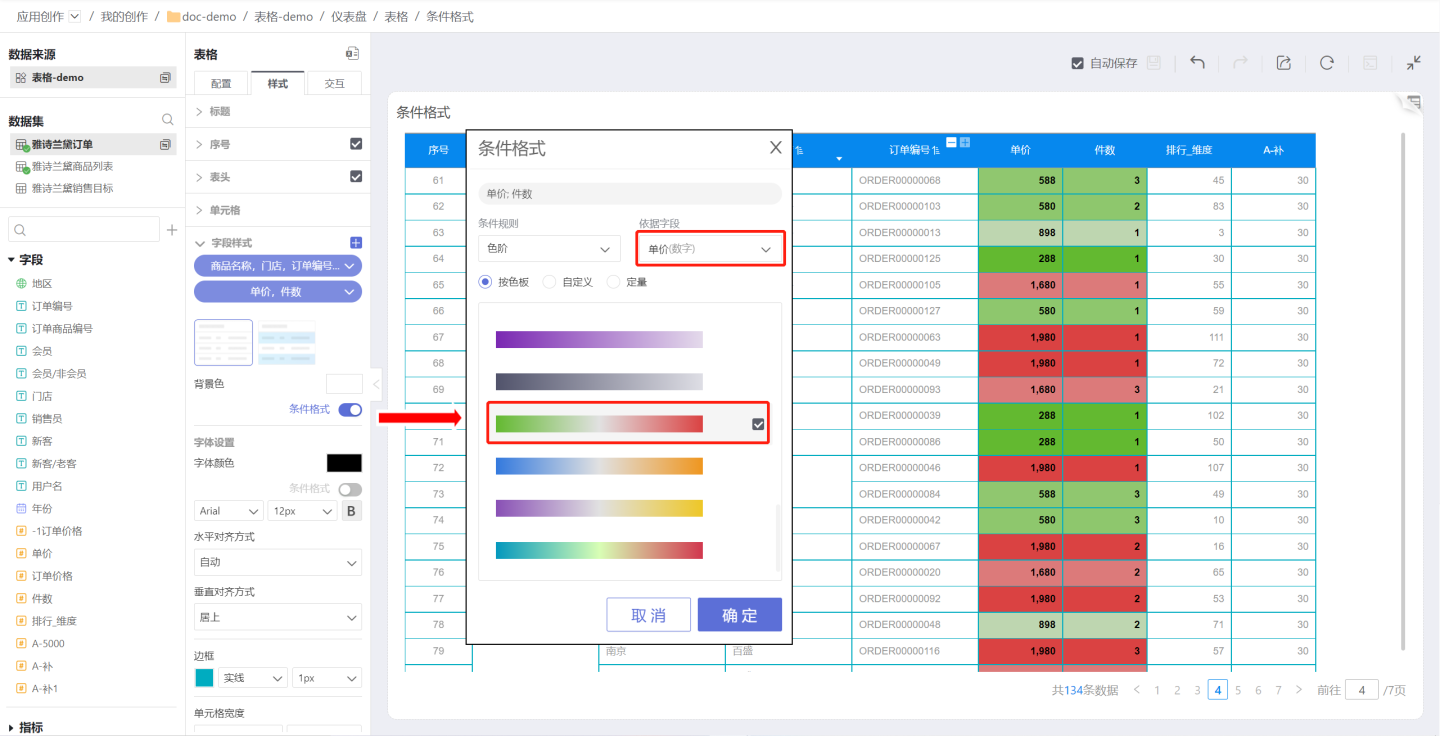
Custom: Customize the color scale for rendering. You can set the number of steps, reverse the colors, and define the start, end, and center values along with their corresponding colors. As shown in the example, set the start and end values in the custom settings for rendering. Values outside the range will not be rendered.
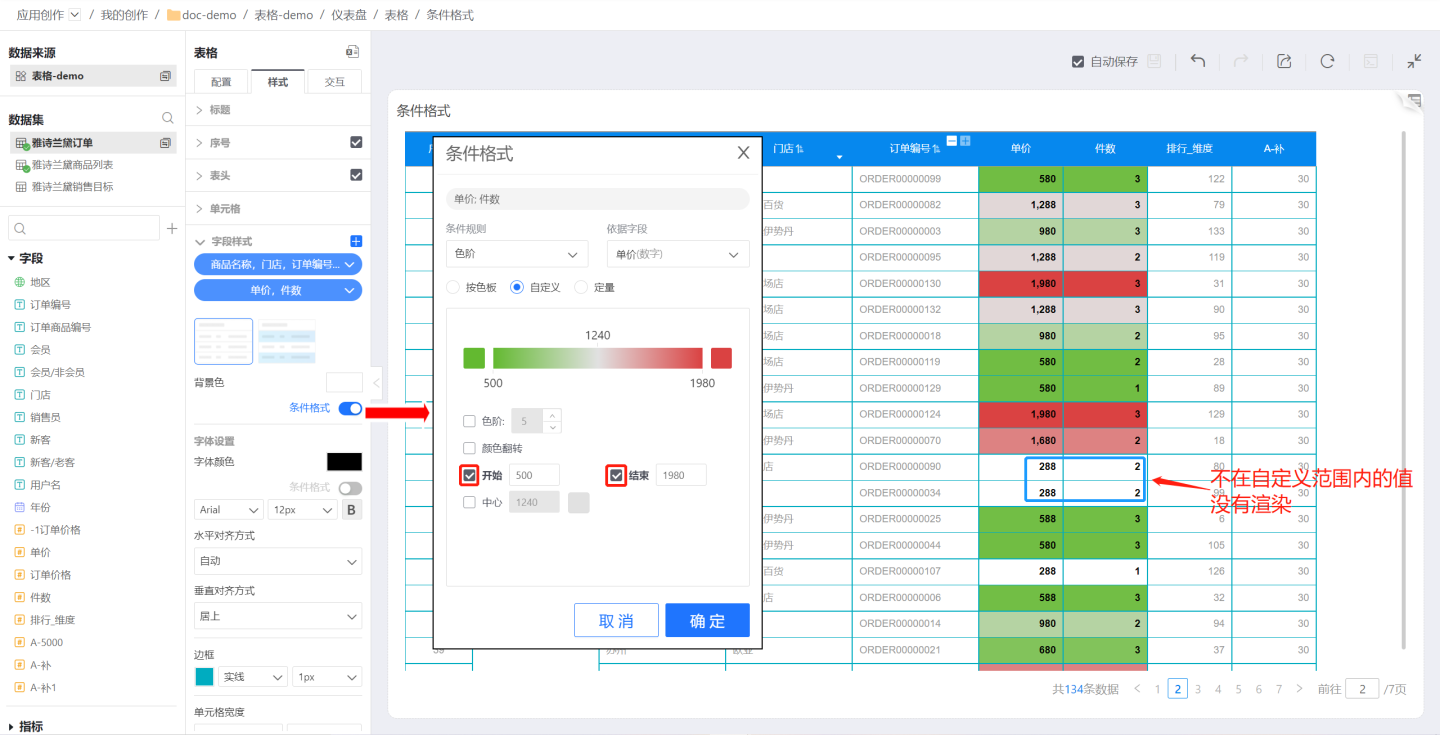
Quantitative: Set the number of color scales, each corresponding to a specific value and color. In the example, 5 color scales are set with corresponding colors and value ranges. If a value is not within the set range of the color scale, the cell will not be rendered.
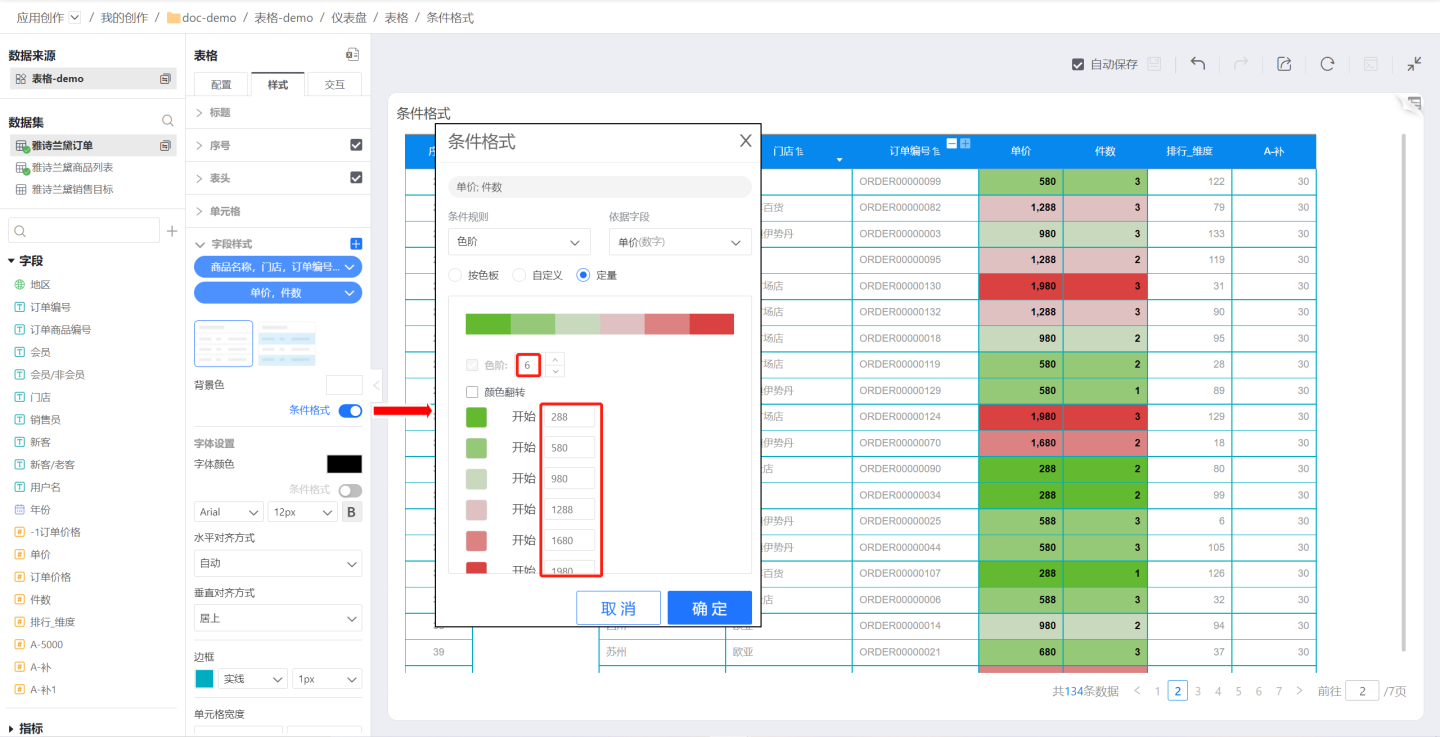
Notes
- If the value in a cell is not within the set range of the color scale, the cell will not be rendered.
- If the start, center, and end values are not set in the custom color scale, the system will default to using the minimum, center, and maximum values of the first field in the field style as the start, center, and end values of the color scale.
Max/Min
Use the max/min settings for conditional formatting to render the maximum or minimum values in a field. It supports setting conditions using "count" and "%". Multiple conditions can be set, and the latter conditions will override the rendering effects of the previous ones.
In the example, it is required to mark the top three products by unit price. In the conditional formatting, set the display colors for the top 3, top 2, and top 1 respectively. As shown in the example, the latter conditional formatting overrides the previous ones. The final result is that the 1st, 2nd, and 3rd places are rendered with different colors.
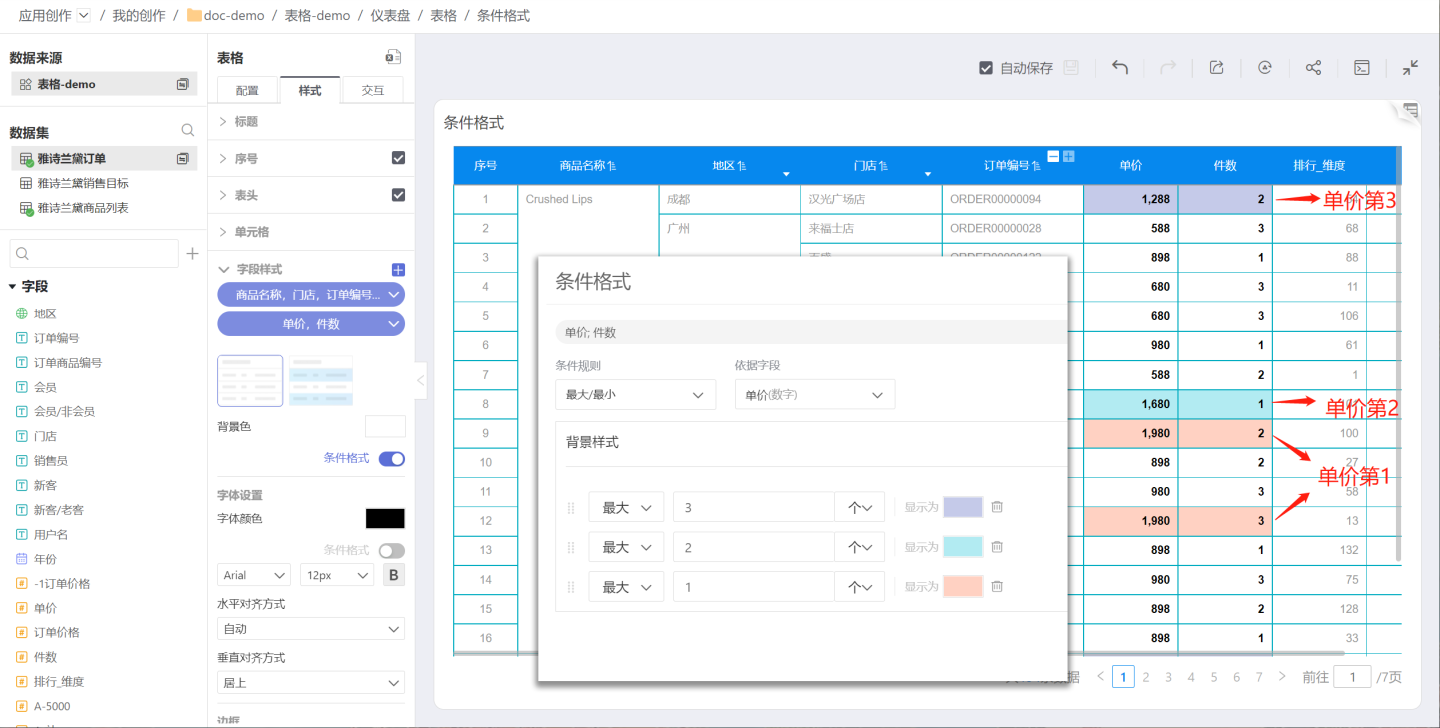
Rules
Using rules to set conditional formatting involves logical judgments based on fields such as >, ≥, <, ≤, =, !=, contains, does not contain, between, not between, empty value, NULL, etc., to define conditional styles. Multiple conditions can be set in the rules, and the latter conditions will override the rendering effects of the previous ones. For example, to mark different price ranges, the price ranges are divided into 0~1000, 1000~1500, 1500~2000. The example uses comparison operations, and the latter rules override the previous ones, forming price ranges. Users can try using the between rule to achieve price range rendering.
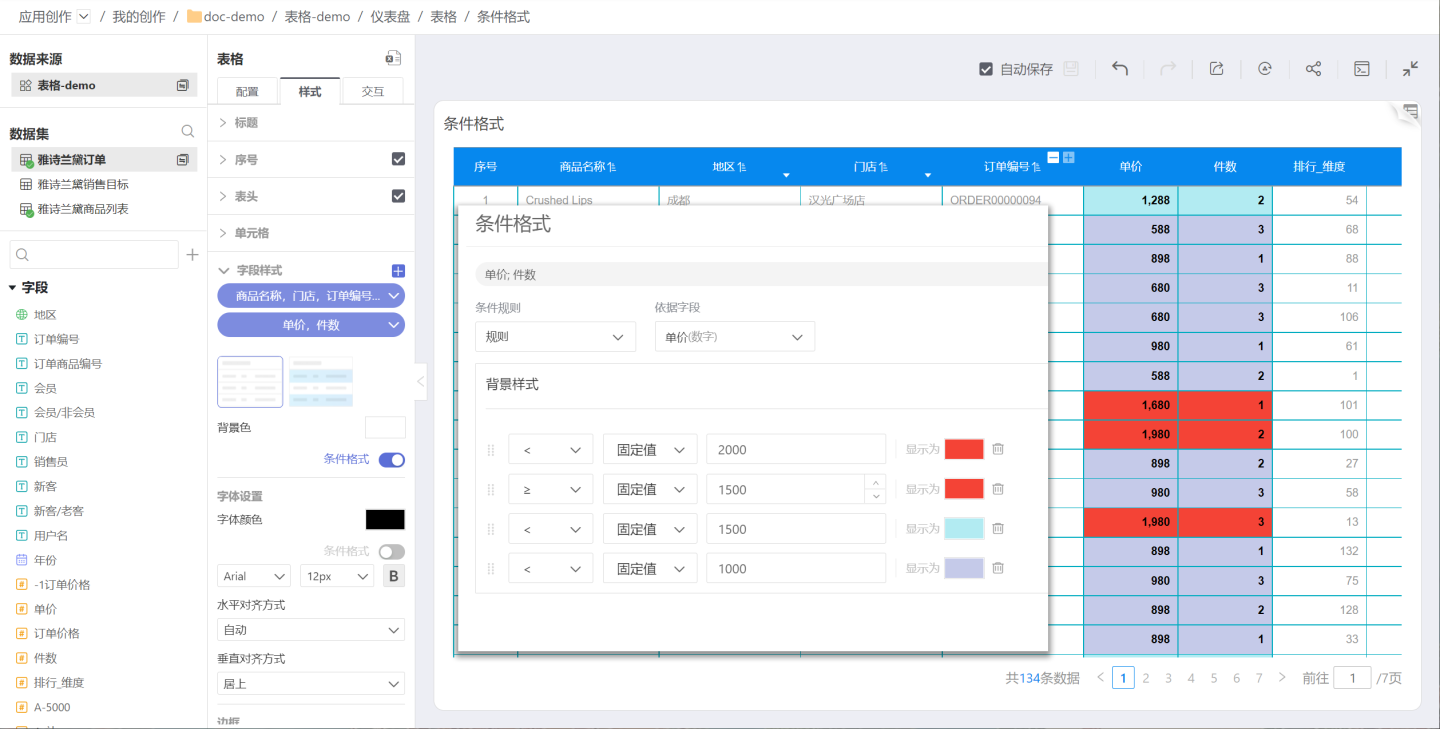
Note:
- When setting maximum/minimum and rules, the rendering results of the latter conditions will override those of the previous conditions, so the order of conditions is important.
Edit Field Styles
After creating each field style, you can re-edit the fields within it. Click the "dropdown arrow" on the right side of the label and select "Edit Field" to reselect the field.
Note
If a field is grayed out when selecting, it means that the field has already been assigned a field style. A field cannot exist in two field styles simultaneously.
Restore Default Styles
Restore the settings in the field styles to the default styles.
Delete
After deleting the field style, all settings will become invalid.
Subtotal
The table supports subtotals including position, font color, alignment, background color, etc., and each subtotal can be set individually. Subtotals occupy one row in table statistics.
- The position of dimension subtotals can be set at the top or bottom. In the example, the subtotal for the region is a dimension subtotal, and its position is set at the top.
- The comparison dimension subtotal for measures can be set on the left or right.
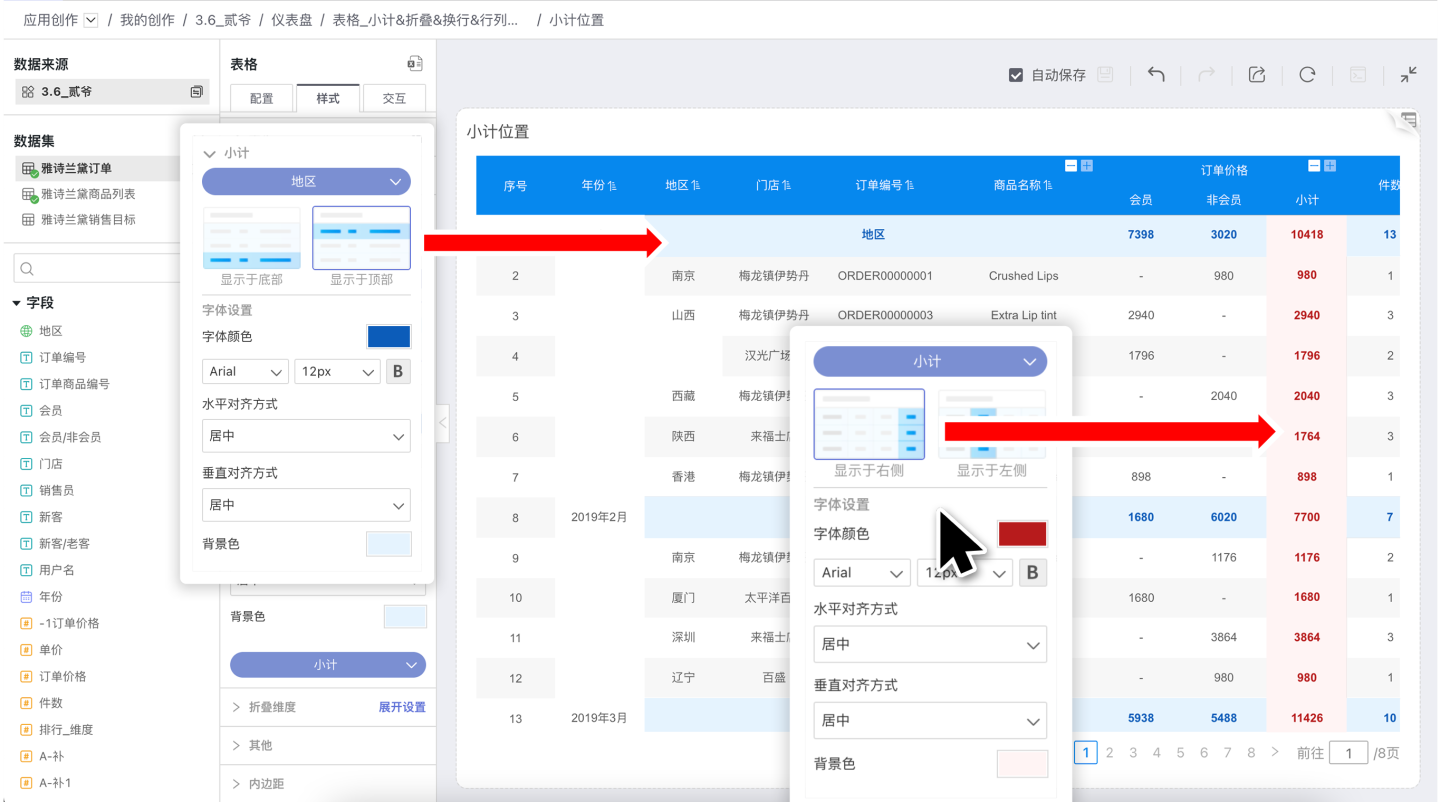
Collapse Dimensions
Tables support the setting of collapsing dimensions. As shown in the figure: after selecting the region in the collapsed dimensions, the table will collapse the region information. 
The expansion setting refers to the user freely setting the expansion state of each level of dimensions, so that the table presents different appearances when displayed. 
Others
- Fill empty rows: Fill when there are empty rows in the table.
- Lock dimension columns: After locking dimensions, the dimension columns remain unchanged during horizontal scrolling. Specific dimension columns can be locked.
